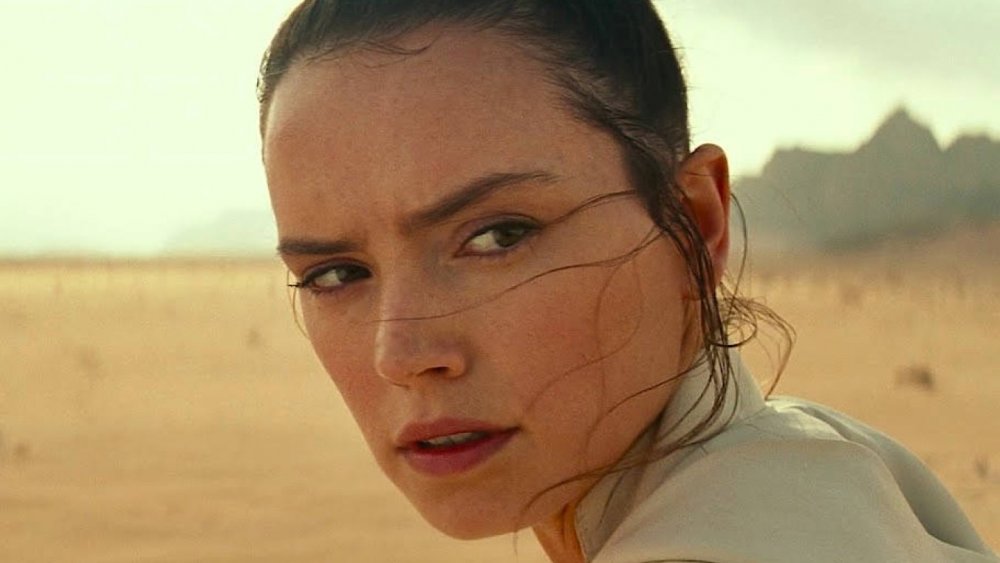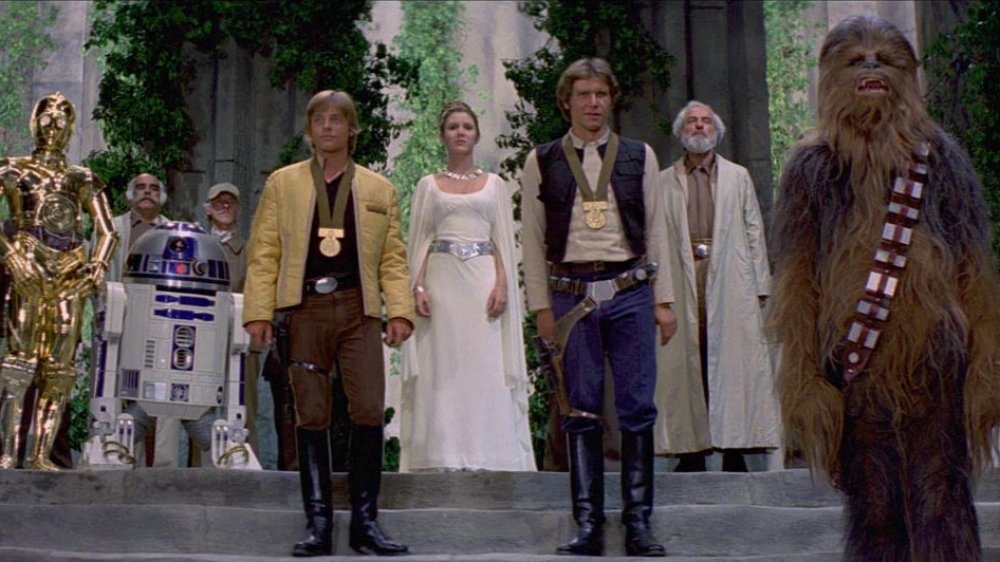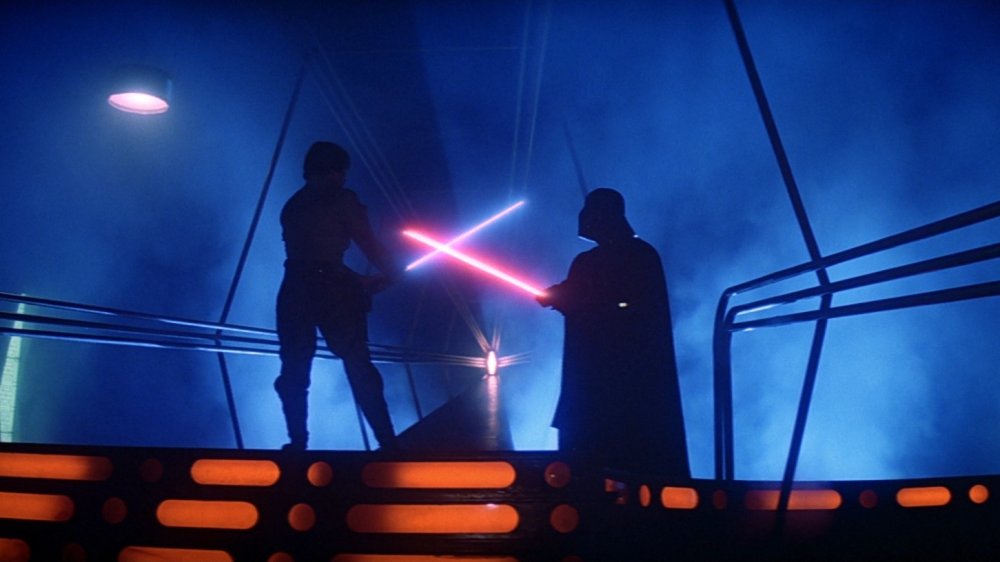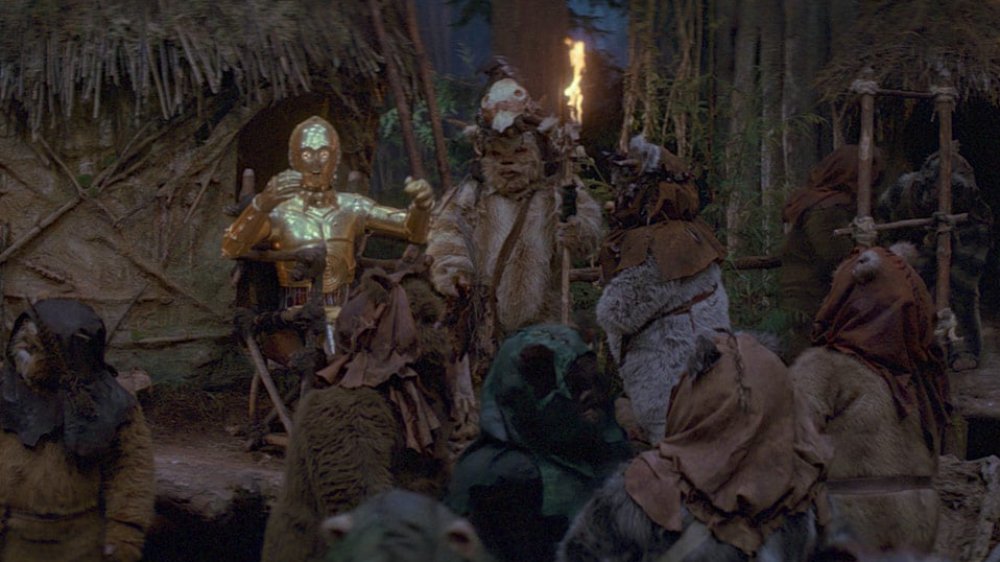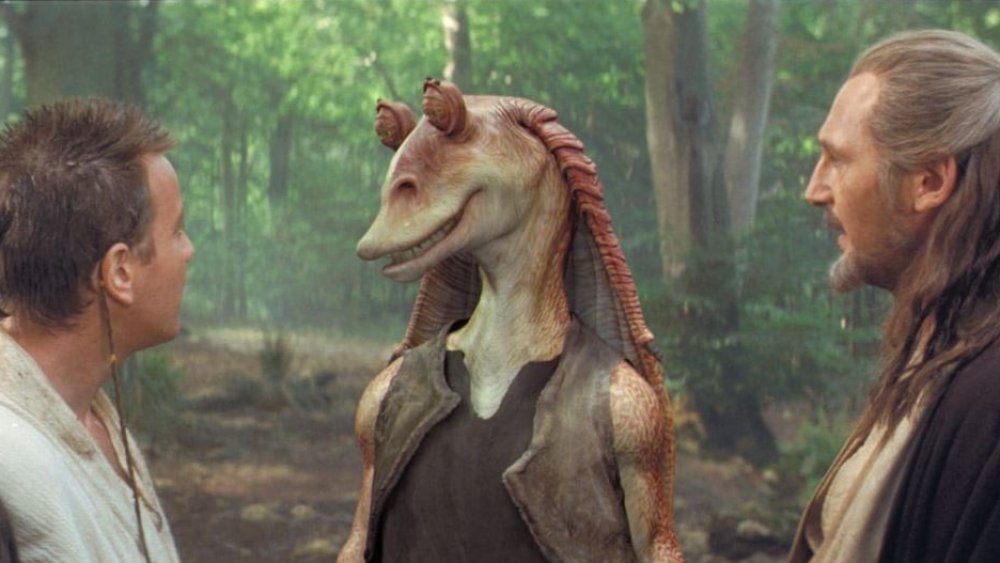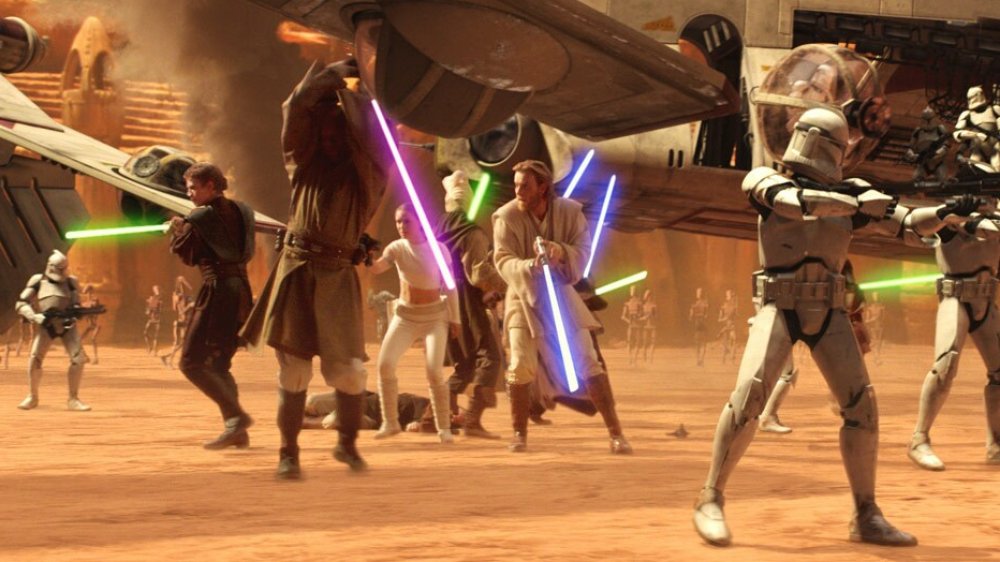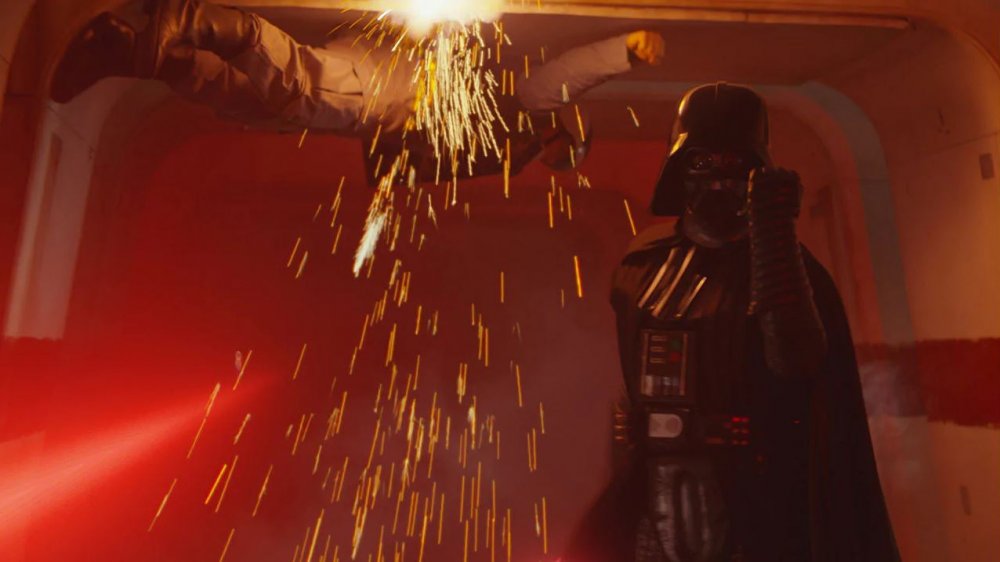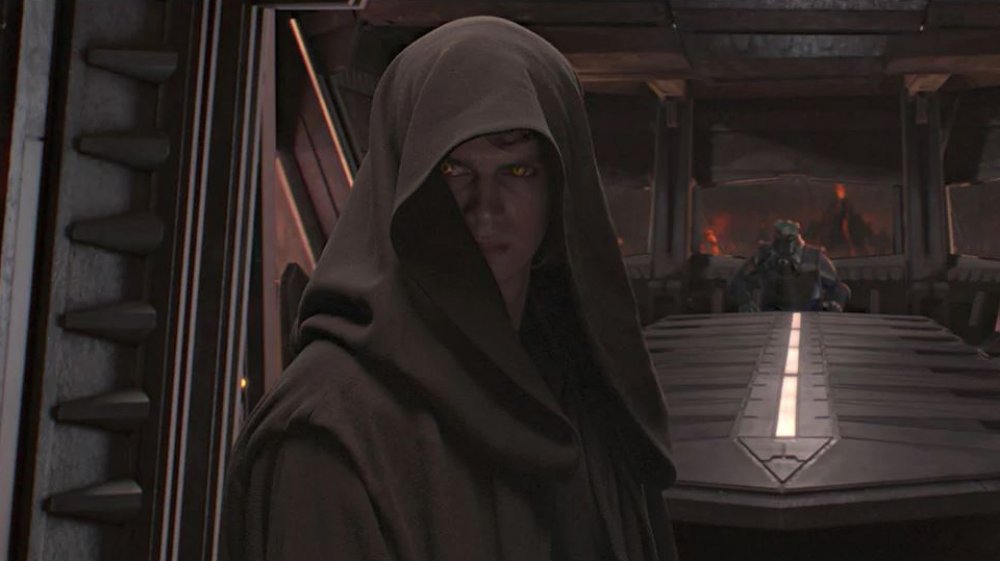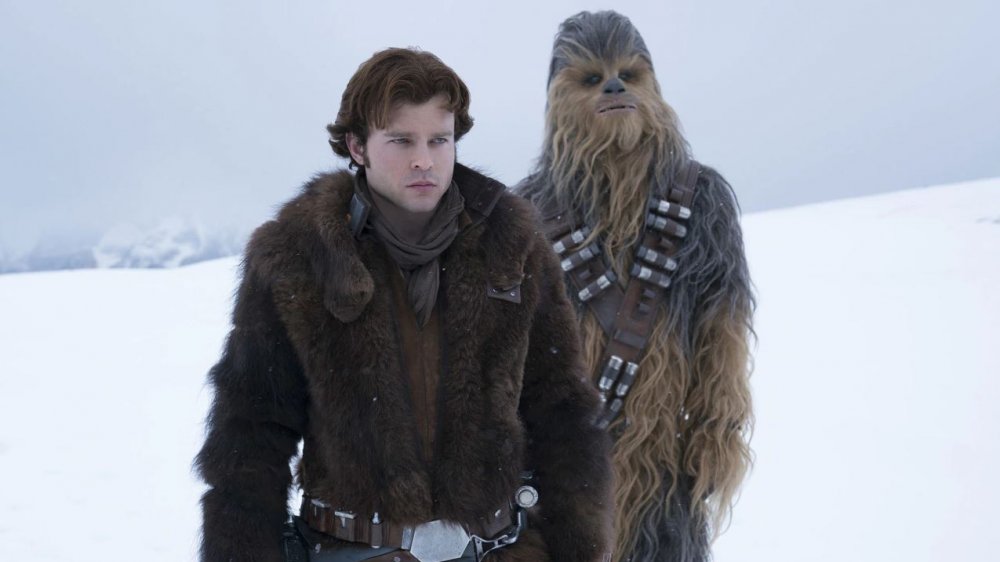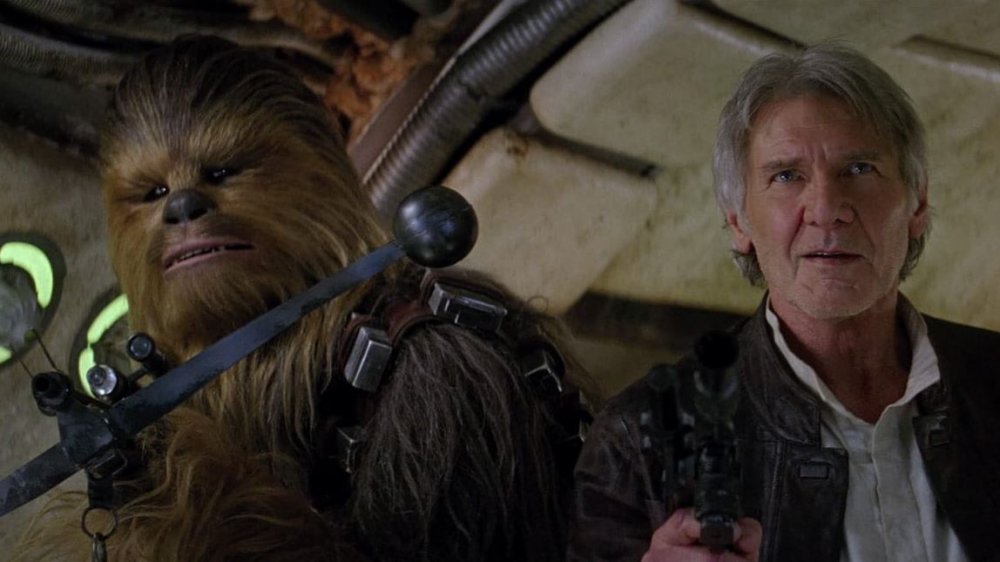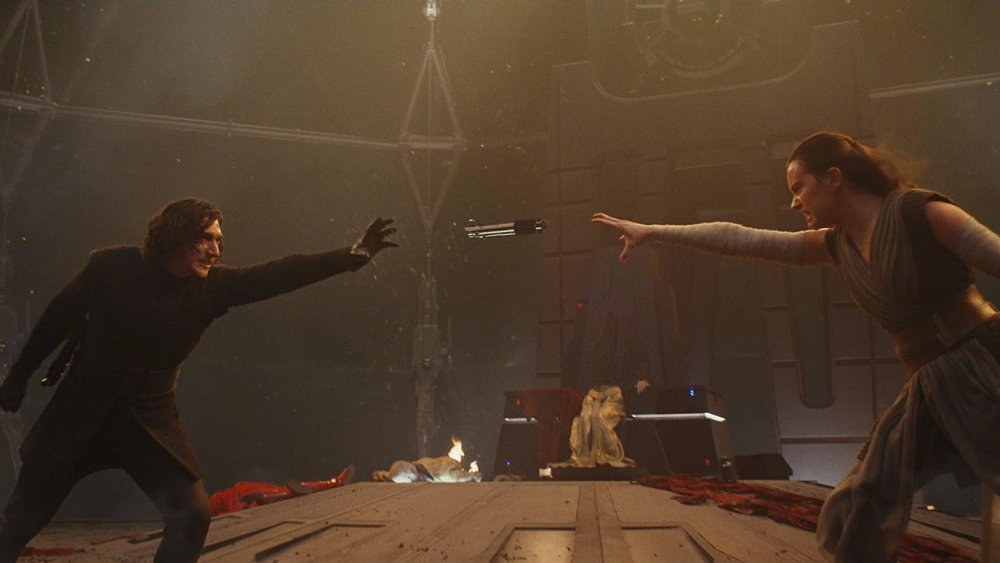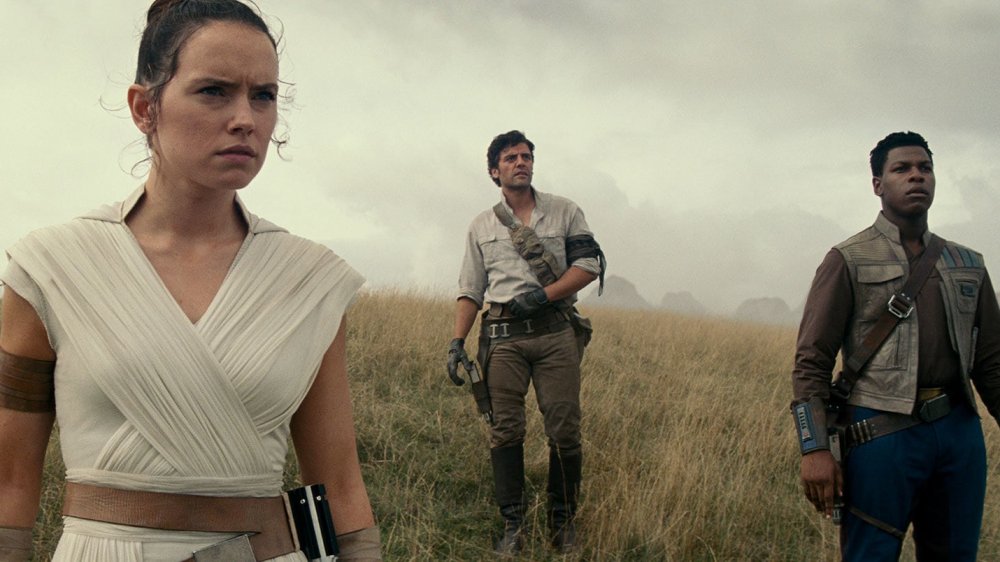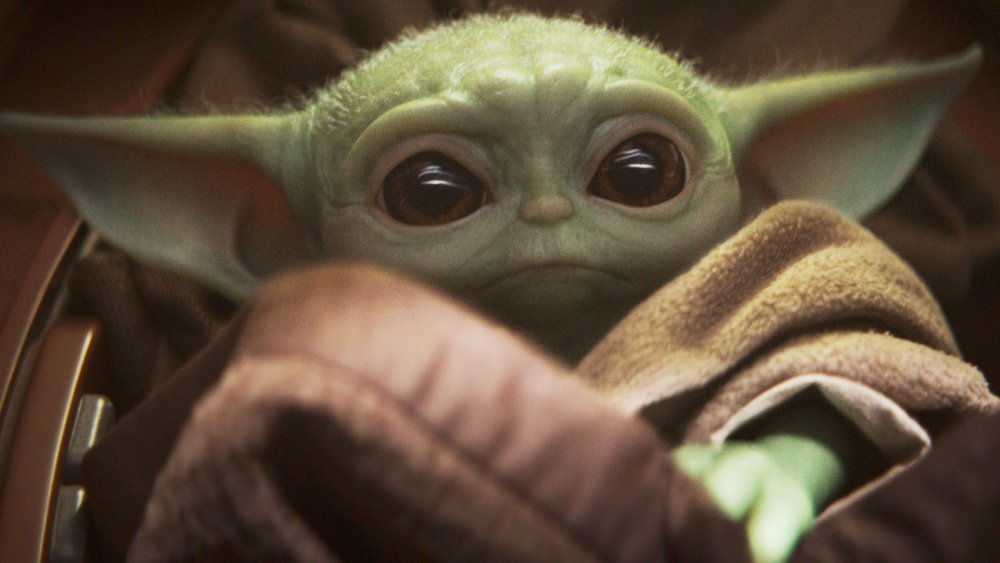This Is The Right Order To Watch Every Star Wars Movie
It's a debate that's raged among Star Wars fans since time immemorial ... or at least since the prequels came out. What's the right order to watch every Star Wars movie? Pretty much everyone has their own opinion about this, ranging from the obvious — like watching them in the order in which they were released or in chronological order based on the story — to more scientific formulas that try to mix up the order based on emotional highs and lows or character motivations. The truth is there's no right answer to this question. Well, except for the order presented in this article. This is the right order.
Our list includes the original trilogy, the prequel trilogy, the sequel trilogy, Rogue One, Solo, and The Mandalorian (yeah, it isn't a movie, but we'll explain later why we're including it). However, we're not including the incredibly disturbing Star Wars Holiday Special or the made-for-TV Ewok Adventures movies from the '80s — Caravan of Courage and The Battle for Endor — because none of those are canon. We're also not including 2008's The Clone Wars movie because we're keeping the list to live-action only. Plus, it's terrible and shouldn't be watched by anyone ever.
So with the rules out of the way, it's time to pour yourself a glass of blue milk and fix a plate of roasted porg as you settle in to watch every Star Wars movie in the proper order.
(Major spoilers for every Star Wars film to follow!)
Start off with Star Wars: A New Hope
If you're going to make the commitment to watch every single Star Wars movie, there's only one place you can logically start — and it's not with Episode I. The first three Star Wars movies, commonly referred to as the original trilogy, remain the defining example of what Star Wars is to this day. Almost everything that's iconic about the franchise, from lightsabers and the Force to droids and John Williams' score, was introduced in the first Star Wars movie, A New Hope. Seriously, this film is what most people think of when they hear the words "Star Wars," and it remains one of the most iconic movies ever made.
By beginning your Star Wars journey with A New Hope (which was originally just called Star Wars, in case you needed further proof of where to start), you're experiencing Star Wars in its purest form. The original trilogy was the only version of Star Wars that existed for almost two decades, and every film that's come since has been loaded with references and callbacks to these movies in a neverending quest to match their reputation and status. And A New Hope alone introduces loads of some of the most recognizable characters in cinema, such as Luke Skywalker, Princess Leia, Han Solo, Chewbacca, C-3PO, R2-D2, Darth Vader, and Obi-Wan Kenobi. The original trilogy is Star Wars, and to fully comprehend the saga you're about to undertake, you need to watch A New Hope first.
Follow that up with The Empire Strikes Back
As we've just established, you're starting your Star Wars marathon with the original trilogy, which means your next appointment is with The Empire Strikes Back. As the direct sequel to A New Hope, the 1980 film — which is often lauded as the best in the franchise — further builds on the characters and story of its predecessor, while also introducing some new franchise icons. Luke continues his Jedi training, working his way up to an eventual confrontation with Darth Vader. Yoda is introduced as Luke's new Jedi master and instantly becomes a fan favorite. Boba Fett is also introduced as the bounty hunter who hunts down Han Solo and freezes him in carbonite. And Lando Calrissian shows up as well, the only man in the galaxy who's cooler than Han Solo. The story developments in the film are also notable, as the Empire gains strength by beating the Rebels at every turn, a relationship blossoms between Han and Leia, and Luke discovers that Vader is his father in one of cinema's most memorable twists.
By following up A New Hope with Empire Strikes Back, you're seeing these iconic characters grow, meeting more memorable Star Wars players, and becoming emotionally invested in the story as the Rebellion sees some major setbacks in their fight against the Empire. The Empire Strikes Back may be the ideal Star Wars movie, but it's also a sequel, and therefore should be watched only after consuming its predecessor.
End the original Star Wars trilogy with Return of the Jedi
By this point, you've watched the first two films in the original trilogy, so the next logical step is ... Attack of the Clones! That's a joke, obviously. Return of the Jedi is up next, as it is — for better or worse — the climax of the original trilogy. The movie gets a lot of hate, especially from modern audiences, for a few of its choices. A lot of people don't like that the movie features a new Death Star. Some aren't crazy about the fact that Han Solo is brought back from his frozen state. And a lot of people really hate the Ewoks. The cute teddy bear aliens are viewed by some as a bridge too far into Merchandise Town, and their ability to defeat the Empire with sticks and stones stretches credibility.
However, Return of the Jedi really isn't as bad as some would have you believe. With proper introductions of Jabba the Hutt and the Emperor, the film continues the original trilogy's tradition of bringing in iconic characters in every installment. It also adds another big twist in the reveal that Luke and Leia are twins. And it features a ton of iconic scenes. There's the escape from Jabba's palace (complete with Sarlacc pit), the speeder bike chase on Endor, and the redemption of Darth Vader. Even the Ewoks, hated as they are, were pretty popular at the time the movie was released and are iconic in their own right. So despite its flaws, Return of the Jedi makes for a satisfying conclusion to the original trilogy.
It's prequel time with The Phantom Menace
There's no way around this so we'll just come right out and say it. The prequel movies aren't very good. They're loathed by many fans, and they don't feel much at all like Star Wars, or at least Star Wars as defined by the original trilogy. Those films told the saga of farm boy Luke Skywalker, who becomes a powerful Jedi warrior, discovers that the murderous Darth Vader is his father, and then overthrows the Emperor. The prequels take place prior to Luke's birth (for the most part) and reveal how the Chosen One of the Jedi, Anakin Skywalker, becomes Vader, the scourge of the galaxy and Palpatine's right-hand man. It's an interesting concept, but one that the prequel movies don't pull off terribly well — especially in this first installment.
The Phantom Menace is mainly remembered for a few, let's say, misguided decisions. One is an over-reliance on CGI, which looks incredibly dated today (and somehow worse than the original trilogy's practical effects). Second is a heavy focus on the political machinations of the Galactic Republic rather than, you know, action and adventure. And third is Jar Jar Binks, the kid-friendly, all-CGI character that everyone loves to hate. The Phantom Menace just doesn't feel like Star Wars to many fans, but if you're determined to watch every movie in the franchise, you might as well watch this one while the memory of the original trilogy is still fresh in your mind.
Get ready for Attack of the Clones
Attack of the Clones heard your complaints about The Phantom Menace ... and it doubled down on all of them. The second film in the prequel trilogy takes the unrealistic CGI to cartoonish levels, and it features even more boring senatorial machinations. But it gets worse. Attack of the Clones replaces the villainous Darth Maul, one of the only cool aspects of The Phantom Menace, with Christopher Lee and a bunch of non-threatening CGI soldiers that look like they came out of a video game (and an extremely old game at that). There's also a forced romance between Anakin and his future wife Padme, and the pair probably have less chemistry than any movie couple ever. Pretty much the only good thing about Attack of the Clones is that it features less Jar Jar Binks than its predecessor.
So why watch Attack of the Clones at all if it's so terrible? Well, it still advances the story of Anakin Skywalker's eventual turn to the dark side, albeit clumsily (the guy hates sand, all right?), and the Clone Wars are a pretty significant part of Star Wars lore, so it doesn't hurt to see what kicked them off. It may be a slog to get through, and it's nowhere near as entertaining as the original trilogy, but Attack of the Clones is still a part of the Star Wars story, and it should be watched right after The Phantom Menace.
Let's flash forward to Rogue One: A Star Wars Story
After watching the first two prequels, you may be wondering just what you've gotten yourself into. In fact, you're probably asking yourself, "Why am I learning about midi-chlorians and listening to Anakin complain about sand? Where's all the cool Star Wars stuff?" That's why we recommend taking a brief respite from the prequels to remind yourself of why you're forcing yourself to sit through them to begin with, and that reason is Darth Vader. The prequels, clumsy as they may be, are all about Anakin's transformation into the Sith Lord. It's easy to forget that while watching the first two episodes, which is why you should follow up Episode II with Rogue One: A Star Wars Story.
The movie is the darkest of all Star Wars films, as the bulk of its characters don't survive past the end of the movie. In other words, this isn't the start of a new trilogy. The story takes place right before A New Hope, and it centers on the group of Rebel spies who steal the plans to the Death Star immediately prior to the start of that film. So given the time period in which Rogue One takes place, that means we get Darth Vader at the full height of his powers and villainy, and it's glorious. With modern effects, Vader is transformed into a more frightening and impressive presence than ever. Watching him slaughter a bunch of Rebel soldiers will remind you of why you're watching the prequels, and it may even get you excited to watch the final prequel movie so you can witness his origin.
Witness the rise of Darth Vader with Revenge of the Sith
Congratulations, you've made it to the final prequel movie! The good news is that it's considerably better than the previous two prequel films. The bad news is that it's still not great. Revenge of the Sith finally gives us the evil Anakin Skywalker we've been waiting for, and while there are still issues with bad CGI, horrible dialogue, and a few iffy performances, it at least tells a pretty compelling story. Anakin fully turns to the dark side of the Force, taking on the identity of Darth Vader and doing all sorts of horrible things. He kills a bunch of Jedi-training kids, Force chokes his pregnant wife, and is just an all-around evil dude. And frankly, evil Anakin is way more interesting than podracing Anakin, lovesick Anakin, or any of the other Anakins who've popped up in the earlier prequels.
Plus, near the end of Episode III, Anakin completes his transformation into full-on Darth Vader with the suit and everything, and it's admittedly pretty cool. The transformation occurs after Anakin is rebuilt following a lightsaber duel with Obi-Wan that left him severely debilitated, which gives some nice emotional weight to the scene. And once you see Anakin put on that iconic Vader mask for the first time, you'll instantly flashback to visions of Vader being menacing and awesome in the original trilogy and Rogue One. And for a brief shining moment, sitting through the entire prequel trilogy will have seemed worth it.
Let's reunite with Han in Solo: A Star Wars Story
By this point, it's been an epic four movies since you've seen any of the "big three" characters from the original trilogy — not counting the baby Luke and baby Leia cameos in Revenge of the Sith. With a total of seven films in the bag, you've now watched more movies without Han Solo than with him, so it's time to rectify that unpleasant situation by screening Solo: A Star Wars Story. The 2018 film may have a bad reputation, but it's one that isn't wholly deserved. The film's infamous director shakeup, its casting of an actor not named Harrison Ford to play Han, and its premiere date of just five months after the divisive The Last Jedi all led to an underwhelming box office take and tepid critical response. Solo's lackluster performance caused Disney to rethink its strategy with Star Wars movies, which has resulted in a break from standalone movies. But despite its controversy and failure to leave a significant mark on the Star Wars universe, Solo actually makes for a pretty fun watch.
Don't get us wrong, it's not a great film by any means, and there's certainly nothing revolutionary about it. It's a mostly by-the-numbers adventure set in the Star Wars universe that features some new interpretations of old characters (Donald Glover's Lando is a highlight), some cool alien creatures, and lots of fun fan service. Also, watching Solo now and getting reacquainted with Han makes his storyline that much more poignant in the next film on the list.
The sequel trilogy begins with The Force Awakens
You're nearing the end, so it's time for the sequel trilogy. Only time will tell just how iconic this trio of films will end up being, but there's no denying their success, especially The Force Awakens. The first Star Wars movie to be released by Disney grossed over $2 billion worldwide, and it remains the highest-earner of all time domestically with a $936 million take. The film brought back almost every character of note from the original trilogy, making sure that anyone burned by the prequels' weirdness would be treated with a heavy dose of the Star Wars they remembered. Leia commanding Rebel Resistance forces? Check. Han and Chewie flying the Millennium Falcon? Check. Luke Skywalker, uh, being there? Check. The Force Awakens also introduced a variety of new characters, and though the fan bases dedicated to Rey, Finn, Poe, and Kylo Ren may not quite match the fervor attached to their original trilogy parallels, the characters are now undeniably a big part of the Star Wars story.
Plus, if you find yourself really missing the original trilogy after watching the prequels, then you should especially enjoy The Force Awakens because it basically retells the story of A New Hope. A nobody finds out she can use the Force and joins up with a group of rebels to fight a guy in a black helmet so they can stop him and his evil empire from using a superweapon that can blow up planets. It may not be original, but it's definitely Star Wars.
Prepare yourself for controversy with The Last Jedi
The Last Jedi is probably the weirdest Star Wars movie ever. The sequel to The Force Awakens doesn't really build on any of the threads that were started by its predecessor. Who are Rey's parents? Doesn't matter. Who is Snoke? Doesn't matter. Didn't Finn already have a character arc where he learned to be brave and commit himself to a greater good? Doesn't matter, he's doing it again. The Last Jedi almost seems to purposely undo pretty much every decision that was made in The Force Awakens, and while some thought this kind of shakeup was the exact kind of bold thinking the franchise needed, others thought it was poor storytelling and a disservice to the fans. This dichotomy has led to the film being labeled as the most divisive in the Star Wars canon.
The Last Jedi is so jarringly different from other Star Wars movies that it almost feels as if you could watch it anywhere in this sequence and it wouldn't matter, but since it's the sequel to The Force Awakens, we're placing it here. Though it's true the movie doesn't seem to have much respect for its predecessor, it does still move the story along in a few important ways. Rey and Kylo Ren both grow, with her becoming a Jedi and him becoming the new supreme leader of the First Order. The pair also develop a weird sort of connection that wasn't very present in The Force Awakens but that ends up forming the backbone of this sequel trilogy.
Finish the Skywalker saga with Star Wars: The Rise of Skywalker
Hoo boy, the sequel trilogy is strange. So, you know how The Last Jedi undid everything The Force Awakens did? Well, The Rise of Skywalker undoes pretty much everything The Last Jedi did. It turns out Rey is actually Emperor Palpatine's granddaughter, Snoke was created and controlled by Palpatine, and Finn ... well, Finn still doesn't really do very much. The movie seeks to satiate fans by giving them the most Star Wars-y Star Wars movie ever, with more lightsaber fights, classic characters (Lando! The Emperor! Han?), and planet-destroying weapons than they can handle. And while critics were unkind to the film, the response from fans has been more positive, and no one can accuse The Rise of Skywalker of being boring. The film gives a satisfying end to the Skywalker story with Kylo Ren/Ben Solo's redemption, and by bringing back the Emperor — the main villain of both previous trilogies — it makes all three trilogies feel more connected.
Although it may not be the sequel trilogy that George Lucas had planned or even wanted, it's probably closer to what the majority of fans wanted. The sequel trilogy wraps up and puts a bow on most of what we've seen from big-screen Star Wars up to this point, which is why it makes sense to end your movie journey with this film. Love it or hate it, this is the end of the Skywalker saga that has defined the franchise for over 40 years. But as you'll see below, it's not the end of Star Wars.
The Mandalorian is the future of the Star Wars universe
The Mandalorian is many things, but a movie isn't one of them. So why is it on this list? Because the series represents the future of Star Wars, and the next Star Wars movies are probably going to look a lot more like The Mandalorian than anything that's come before. Plus, as the first-ever live-action Star Wars TV show, its eight-episode first season had a blockbuster feature film budget and as much content as at least two movies, so comparing it to a film isn't as outrageous as it seems.
Ever since the original trilogy, Star Wars movies have been about the past. The prequel movies tell the story of young Anakin Skywalker, Rogue One and Solo are both prequel stories based on A New Hope characters and concepts, and the sequel trilogy is more concerned with wrapping up the storylines of the original trilogy's characters than it is with charting its own course. But that's not true for The Mandalorian. The series has yet to feature a single character from another Star Wars movie, and while there are certainly plenty of Easter eggs for fans to drool over, they're hardly central to the story. It's the first standalone Star Wars tale that truly feels standalone, and its lack of connections to the Skywalker saga shows a path forward for the entire franchise. No longer bound by decades-old stories and trilogy formats, Star Wars is now free to finally explore more of the galaxy far, far away.
